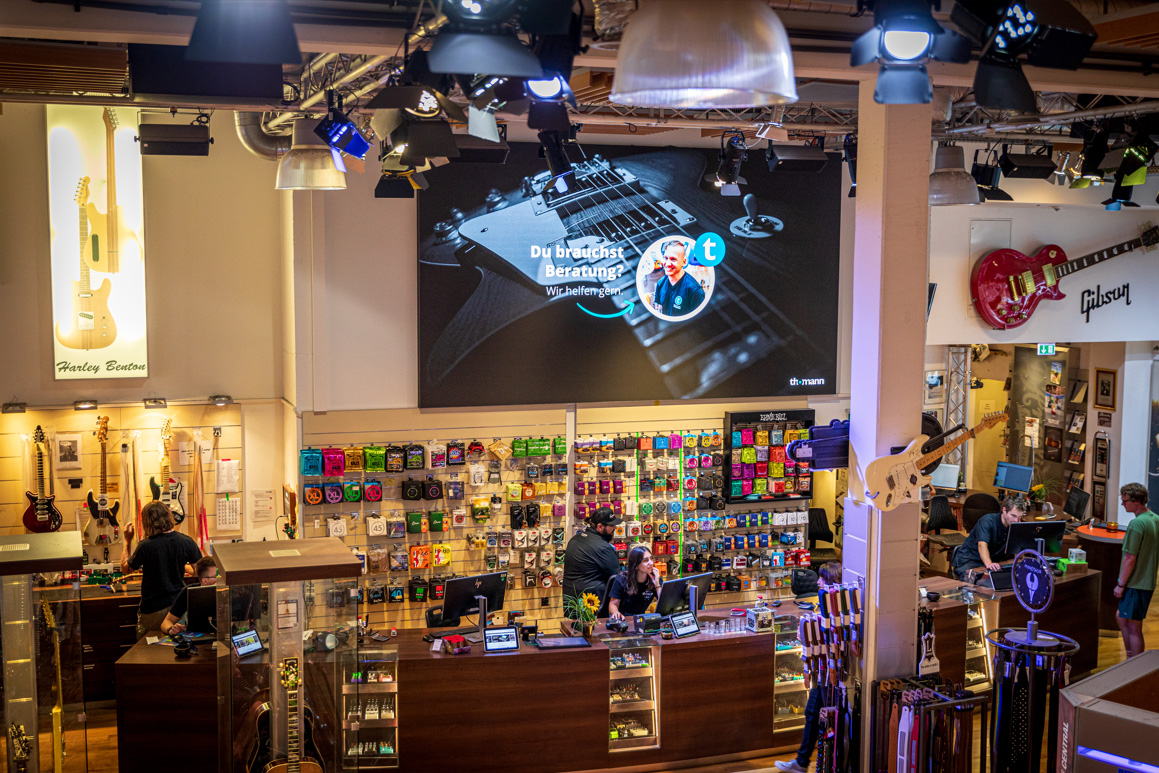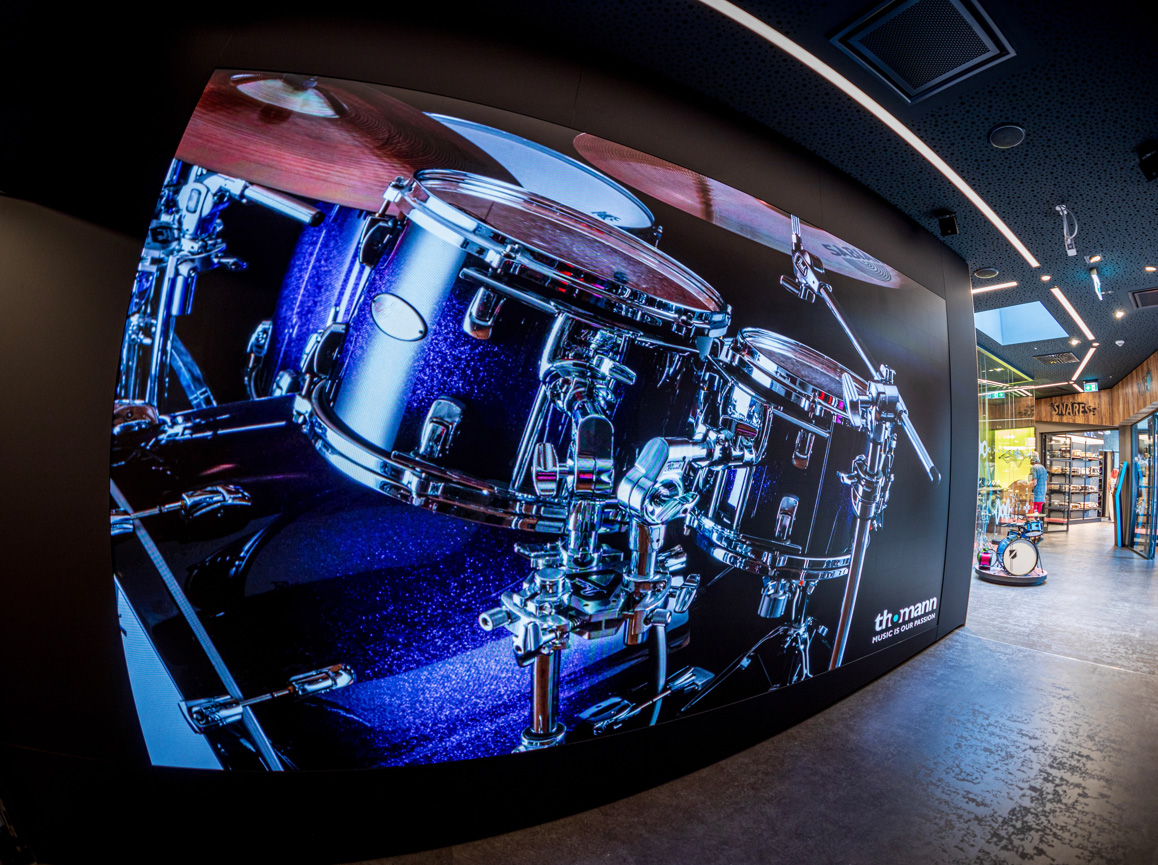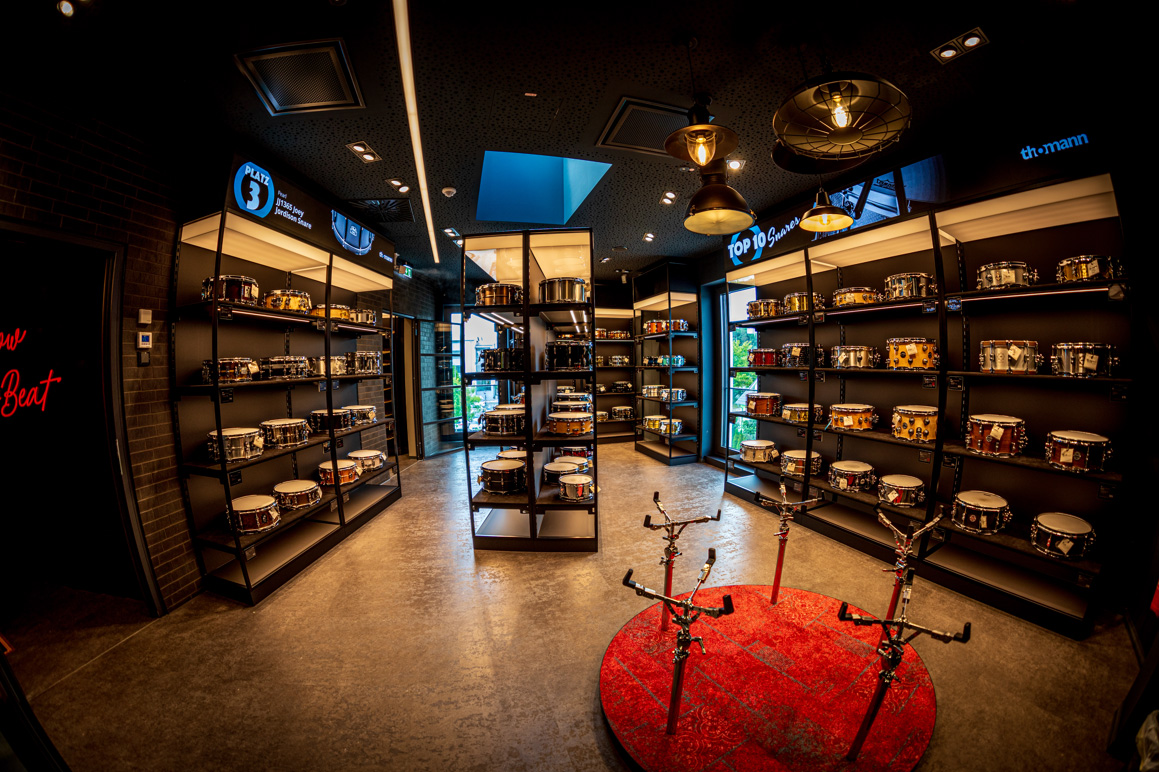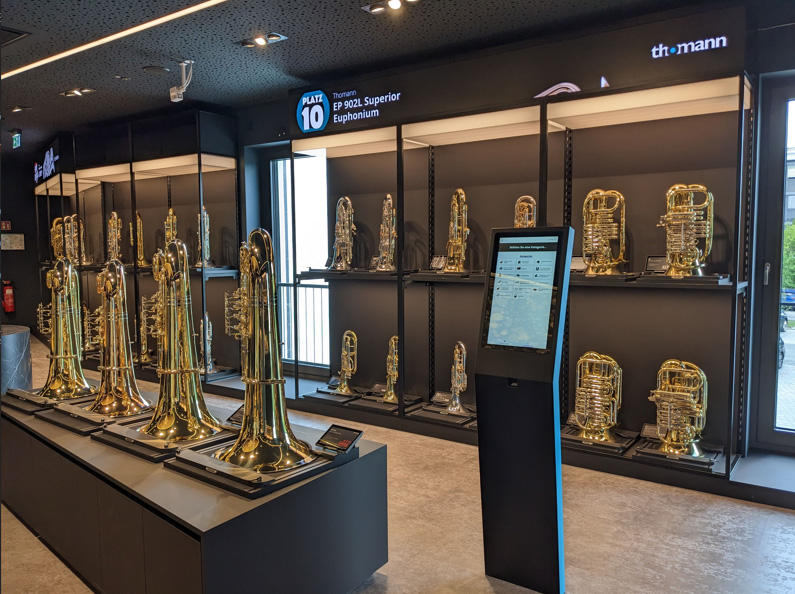Musikhaus Thomann in Treppendorf near Bamberg in Upper Franconia combines tradition and modernity: founded in 1954 by musician Hans Thomann Senior and still independent to this day, the family business was the first music retailer in Germany to go online with its own website in the mid-1990s.
Today, the traditional company with its 1,700 employees serves more than 17 million customers worldwide via Europe's largest online mail order business for musical instruments and equipment and its retail store. Thomann also has its own logistics center with over 40,000 square meters of storage and shipping space and its own service center.

Image 1: The use of LED technology enables Thomann to address customers in a comprehensive and individually controllable way - from classic manufacturer promotions to bestseller lists and video testimonials from well-known influencers in the music sector.
2019 also saw the start of the ambitious expansion and conversion of the store, which will be the largest music store in the world with an impressive 15,000 square meters of sales space when it is completed in 2027. The new drum and brass departments have been built on two floors in the first construction phase already. The second part of the building, which is currently under construction, is intended for acoustic guitars, keyboard and string instruments as well as studio technology. In the existing building, for which an extensive facelift is planned, music professionals will also find everything they need for lighting and system technology and DJ equipment.
"With our business model, we are exotic among musical instrument retailers. Our successful online store will be reflected in our stationary business, which focuses on detailed advice, by combining online and offline in a meaningful way using modern technology. We are putting our heart and soul into this project,"
explains Florian Rittweger, Director Sales at Thomann and a musician himself, who is closely involved in the remodeling and expansion of the store and is responsible for planning the digital projects within the long-established company.
"The use of LED technology now allows us to address customers flexibly and individually," continues Rittweger."This ranges from classic manufacturer promotions and bestseller lists of our most popular and best-selling products to video testimonials from well-known influencers from the music industry with whom we work."

Image 2: Creative use with a personal touch: An LED wall in the passageway to the new building in the drum department uses a motion sensor to automatically play videos specially produced by Thomann showing team members of the advisory staff playing drums.
Two particular highlights are a 4.20 m x 3.27 m LED wall in the guitar department and an identical LED wall in the passageway to the new building leading to the drum department, which automatically plays content using a motion sensor. A particularly creative approach with a personal touch is the use of videos specially produced by Thomann, which show various members of the advisory team playing drums.
"For the entire project, it was important for us to also highlight our employees, who are all musicians themselves, as the people behind the online music store. After all, our high standards of profound online and offline advice, so that we can recommend the right instrument or product for every customer, is a cornerstone of our success," says Rittweger.
In addition to LED walls, a total of twelve LED strips were installed above the product shelves in the drum and brass departments in the completed store extension, which can be individually programmed with content. At five custom-made product application stations, specialist staff and customers can also use touchscreens to browse the entire range of musical instruments and equipment and scan goods from the shelves to obtain further information.
"With the digitalization of our stationary retail, in addition to our online retail, we wanted to create a special customer experience that is designed for entertainment and at the same time supports customers in their purchasing decisions as well as specialist staff in their work,"
explains Rittweger. "In addition to LED technology and our product application steles, we also use digital price tags that update prices automatically via the connection to our database. This automation saves a lot of time for our specialist staff, who can concentrate on advising customers instead."
"Another advantage of using LED technology is that it supports our design concept, which was very important to us when expanding and modernizing our store," says Rittwerger. "The different lighting moods that we can create by playing different content have met with a very positive response from our customers."
"When integrating the display hardware at Thomann, there was a high demand for visual appeal and a uniform appearance. At the same time, we needed the efficient use of PC hardware in order to be able to play a lot of individual content with one PC, as in the case of the LED displays above the product shelves,"
explains Johannes Fischer, the responsible project manager at the Göttingen-based software developer and expert in POS digitization xplace, who accompanied the implementation of the project and supplied all digital solutions from a single source.

Image 3: Giada D611 i5 digital signage players are used for the simultaneous display of individually selectable content on the LED strips above the product shelves, as they have the correspondingly high computing power.
A Giada D611 digital signage player with an Intel i5 processor is used in each department for the simultaneous display of individually selectable content on the LED strips, as this has the correspondingly strong computing power in a compact booksize format. The large LED walls are operated by Giada D611 Celeron models, the product application steles by Giada i58 models.
"We use our in-house content management software BEECEEN for uniform control of the systems," adds Fischer. "With the individual application programmed by us, customers can also select goods from the entire Thomann range at the product application stations."
"We have had very good experiences with Giada's mini PCs in terms of quality, value for money and fast availability, even for the smallest quantities," explains Matthias Koch, Head of Product Management at xplace, who was responsible for purchasing the technology. "The Munich-based value-added distributor Concept International distributes Giada PCs in German-speaking countries and has been a reliable and flexible partner for us for ten years, helping us to always find the right PC for our applications."
"The digital signage players from Giada are characterized by their slim and compact form factor, high reliability and robustness thanks to their metal enclosure. The manufacturer also offers high product quality," adds Martin Polz, Sales Manager at Concept International. "We keep a stock at our headquarters in Munich and also assemble here. This allows us to deliver quickly with tested quality."
"We are extremely satisfied with the technology used, everything has worked perfectly so far," concludes Florian Rittwerger. "We are already looking forward to further planning with our partners regarding the latest technologies that we will use for the other construction phases. Giada players will also be used for this."

Image 4: At customized product application stations, specialist staff and customers can browse the entire range of musical instruments and equipment via touchscreen and scan goods from the shelves to obtain further information.
Customer Information: Musikhaus Thomann
Partner Information: xplace GmbH
All image rights: Photography Marcus Schultz Burgebrach